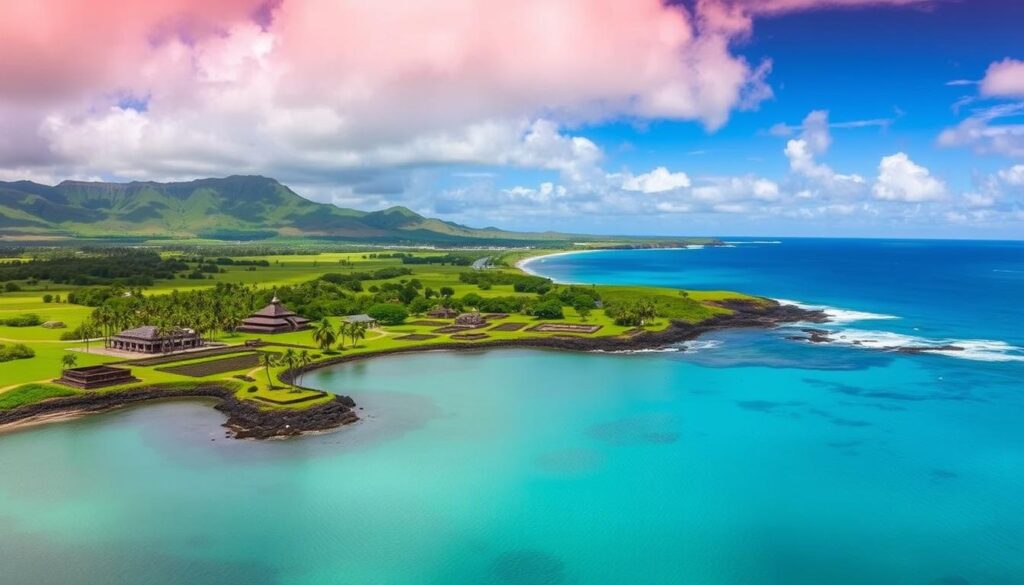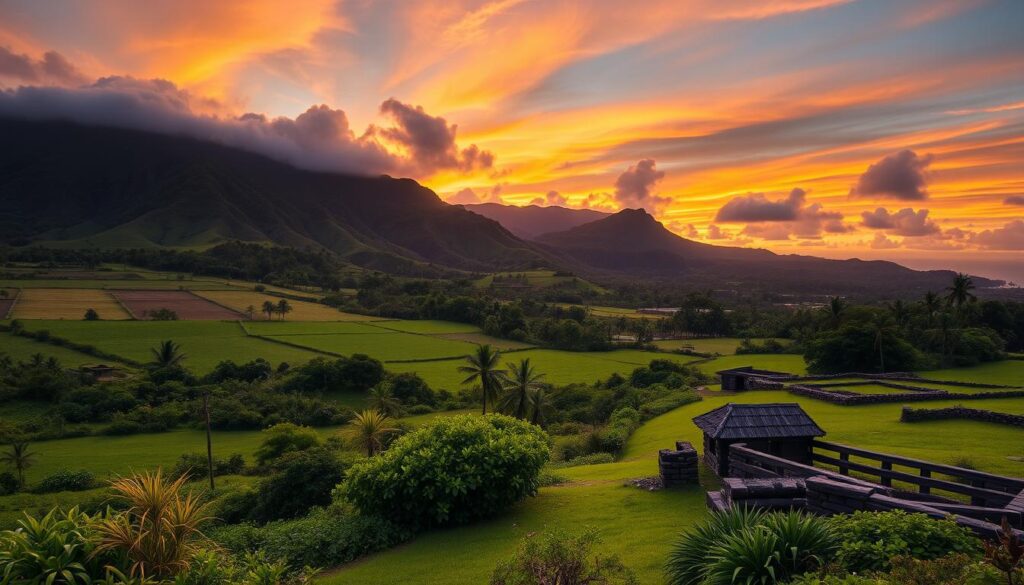Hawaii is celebrated for its vibrant culture, rich history, and breathtaking natural beauty. The islands are dotted with majestic volcanoes, lush rainforests, and pristine black sand beaches. These diverse landscapes make Hawaii a paradise for nature lovers and those seeking adventure. Visitors can delve into the spirit of Aloha by exploring Hawaii’s national parks and protected areas.
Key Takeaways
- Hawaii boasts eight national parks showcasing diverse landscapes from volcanoes to tropical rainforests to coral reefs.
- Hawaii Volcanoes National Park features two active volcanoes, Kilauea and Mauna Loa, drawing a significant number of visitors.
- The national parks in Hawaii offer a rich cultural heritage, with sites like Pu’uhonua o Honaunau and Kaloko-Honokohau preserving the state’s history.
- Hawaii’s national parks are home to a diverse range of plant and animal species, including many endemic species found nowhere else in the world.
- The Hawai’i Pacific Parks Association provides crucial support to the national parks, contributing millions in aid and enabling important conservation efforts.
Exploring the Majestic Hawaiian Landscapes
Hawaii, a stunning archipelago in the Pacific, boasts diverse natural wonders. Two standout national parks, Haleakala National Park and Hawaii Volcanoes National Park, offer a unique glimpse into the volcanic landscapes that have molded the islands.
Haleakala National Park: Hiking and Stargazing
Haleakala National Park, covering over 33,000 acres on Maui, is a true treasure. Its centerpiece, the Haleakala Crater, is a massive volcanic depression. It’s over 3,000 feet deep, seven miles long, and two miles wide. Visitors can witness the awe-inspiring sunrise from the summit, which offers panoramic views of the islands and the Pacific Ocean.
The park also boasts a variety of hiking trails. From the lush bamboo forests of Hosmer Grove to the scenic Pipiwai Trail, which leads to Waimoku Falls. Camping options include Hosmer Grove Campground and Kīpahulu Campground, perfect for wilderness exploration and stargazing.
Hawaii Volcanoes National Park: Volcanic Wonders
The Big Island’s Hawaii Volcanoes National Park showcases the islands’ volcanic power. It’s home to the active Kilauea volcano and the majestic Mauna Kea. Visitors can witness the park’s ever-changing volcanic activity, from glowing lava flows to unique volcanic terrain.
Exploring the park’s diverse hiking trails reveals stunning viewpoints, lava tubes, and active steam vents. The park’s ecosystems, from coastal plains to montane forests, host a wide range of plant and animal species. Many of these species are found nowhere else on Earth.
Kalaupapa National Historical Park: A Poignant Reminder
Kalaupapa National Historical Park on Molokai Island is a poignant reminder of Hawaii’s complex history. It was once a place of exile for those with Hansen’s disease (leprosy). Over 8,000 people, mostly Native Hawaiians, lost their lives here. The park now preserves this dark chapter, honoring those who suffered.
The isolation laws at Kalaupapa ended in 1969. Yet, only about 1,300 graves have been identified. However, Ka ‘Ohana O Kalaupapa has listed over 7,000 names of those exiled. In 2009, President Barack Obama signed a bill to create the Kalaupapa Memorial. It will be a lasting tribute to the victims of this tragic period in Hawaiian history.
The Kalaupapa National Historical Park is a poignant reminder of the isolation and suffering of those with Hansen’s disease. Its remote location, surrounded by towering sea cliffs, highlights the hardship faced by those who lived here. By preserving this history, the park ensures that the stories of those who suffered at Kalaupapa will never be forgotten.
Hawaii National Parks: Gateways to Adventures

Hawaii’s national parks and historical sites are gateways to the islands’ rich cultural heritage and pivotal historical moments. Pu’uhonua o Honaunau National Historical Park on the Big Island is a sanctuary for ancient Hawaiian warriors and those who broke kapu. It offers refuge and absolution. The World War II Valor in the Pacific National Monument, including the Pearl Harbor National Memorial, honors those who lost their lives in the 1941 attack.
Pu’uhonua o Honaunau National Historical Park
Pu’uhonua o Honaunau National Historical Park is a sanctuary of deep cultural significance for Hawaiians. It was a refuge for defeated warriors and those who broke kapu, offering protection and absolution. Visitors can explore ancient temples, royal fishponds, and learn about Hawaiian history and traditions.
World War II Valor in the Pacific National Monument
The World War II Valor in the Pacific National Monument, including the Pearl Harbor National Memorial, commemorates the 1941 attack. It allows visitors to walk in history’s footsteps, visit the USS Arizona Memorial, and understand this critical moment in military history. The park honors the resilience and courage of Americans during a dark period.
These historic sites in Hawaii’s national parks offer a connection to the islands’ cultural heritage and significant events. Whether exploring ancient Hawaiian traditions or honoring World War II veterans, these parks are gateways to unforgettable adventures.
Hawaii national parks: Nature’s Masterpieces
Hawaii’s national parks and protected areas are a testament to the islands’ diverse and breathtaking natural landscapes. The Hawaiian Archipelago, comprising 18 islands, ranges from 4,030 square miles to mere acres. These parks preserve the beauty and wonder of Hawaii’s tropical paradise. They offer visitors a chance to immerse themselves in the islands’ pristine landscapes.
The Kilauea Section of Hawaii National Park, now known as Hawai’i Volcanoes National Park, is home to Mauna Loa, the world’s largest mountain, and Kilauea, one of the most active volcanoes globally. Haleakala National Park, on the other hand, encompasses the summit of Haleakala Volcano, which erupted around two hundred years ago. These parks offer a glimpse into the fiery natural wonders that have shaped the Hawaiian islands over millions of years.
Hawaii’s national parks and protected areas are a true marvel. They feature majestic volcanoes, lush rainforests, pristine black sand beaches, and cascading waterfalls. Visitors can witness Kilauea’s ongoing eruptions, explore the colorful depths of Haleakala Crater, and immerse themselves in the islands’ rich cultural heritage. These natural wonders, preserved for future generations, showcase the incredible beauty and resilience of Hawaii’s tropical paradise.
| National Park | Key Features | Interesting Facts |
|---|---|---|
| Hawai’i Volcanoes National Park | Mauna Loa, Kilauea | Kilauea has been continuously erupting since 1983, creating 500 acres of new land. |
| Haleakala National Park | Haleakala Crater | Haleakala Crater is a colorful depression seven miles in diameter and three thousand feet deep. |
Pearl Harbor National Memorial: A Solemn Tribute
The Pearl Harbor National Memorial on Oahu’s island is a poignant tribute to lives lost in the Japanese attack on December 7, 1941. This event drew the United States into World War II. It serves as a somber reminder of the bravery and sacrifice of those who perished.
Visitors can learn about the events through interactive exhibits and multimedia displays. The USS Arizona Memorial is the memorial’s centerpiece, honoring the 1,177 crewmen who lost their lives when the battleship was sunk.
The visitor center offers a wealth of resources, including over 120 book titles and 50 videos. There are also posters, audio recordings, and other mementos related to the Pacific War effort and the events at Pearl Harbor. These materials help visitors understand the historical significance of the site and the lasting impact of the attack.
The USS Arizona Memorial program offers a 45-minute experience. It allows visitors to reflect on the events of December 7, 1941, and connect with the history and heroes of that day. The Ford Island Bus Tour also grants access to other historic sites, such as the USS Oklahoma and USS Utah Memorials, with expert guides sharing captivating stories of bravery and sacrifice.
The Remembrance Circle exhibit is a powerful tribute to the men, women, and children whose lives were lost. It features a 3D bronze map of Oahu, helping visitors visualize the locations of the attacks and the scale of the devastation.
Interpretive wayside exhibits throughout the memorial use historical images from 1941, overlaid on the modern-day panorama. This creates a profound connection between the past and present. It allows visitors to truly appreciate the gravity of the events that unfolded on December 7, 1941.
The Pearl Harbor National Memorial stands as a solemn testament to the resilience and courage of the American people in the face of adversity. By honoring the memory of those who perished, the memorial ensures their sacrifices will never be forgotten. It teaches us the lessons of the past, guiding us towards a future of peace and understanding.
Honouliuli National Historic Site: Lessons from History

The Honouliuli National Historic Site on Oahu is a somber reminder of a dark chapter in Hawaiian history. It commemorates the internment of Japanese Americans during World War II. This site, the largest and longest-used confinement site in the Hawaiian Islands, preserves the legacy of the Honouliuli Internment Camp.
During the war, the Honouliuli Internment Camp held a population of approximately 400 civilian incarcerees, predominantly Japanese Americans who were U.S. citizens by birth. The camp also held prisoners of war, with facilities capable of accommodating up to 4,000 individuals at its peak.
Preserving the Legacy of the Hawaiian Internment Camp
The Honouliuli National Historic Site ensures that the lessons from this period are not forgotten. It features an education center with photos of the camp, artifacts from the incarcerees, and oral history videos. This provides visitors with a powerful and moving experience.
- The Honouliuli Internment Camp comprised 175 buildings, 14 guard towers, and over 400 tents, spanning 160 acres.
- The incarcerees at Honouliuli included not only Japanese Americans but also individuals of German, Italian, Irish, Russian, and Scandinavian descent.
- The mass incarceration of Japanese Americans on the U.S. mainland affected over 120,000 people, marking the largest forced removal in American history.
By preserving the Honouliuli Internment Camp site, the Honouliuli National Historic Site ensures that the lessons of this difficult period are passed down to future generations. Through education and reflection, visitors can gain a deeper understanding of this pivotal moment in Hawaiian history.
| Key Facts about Honouliuli National Historic Site | Details |
|---|---|
| Largest and longest-used confinement site in Hawaii | Held approximately 400 civilian incarcerees and 4,000 prisoners of war |
| Camp size and facilities | 160 acres, 175 buildings, 14 guard towers, 400+ tents |
| Incarcerees | Predominantly Japanese Americans, as well as individuals of German, Italian, Irish, Russian, and Scandinavian descent |
| Largest forced removal in U.S. history | Mass incarceration of 120,000 Japanese Americans on the mainland |
| Honouliuli Education Center | Features photos, artifacts, oral histories, and virtual tours |
Hiking Trails and Waterfalls in Hawaii’s National Parks
Hawaii’s national parks are a treasure trove for those seeking to explore the islands’ natural wonders. With a variety of hiking trails and the chance to see waterfalls, these parks offer an immersive experience. From the lush Manoa Falls Trail on Oahu to the breathtaking Napali Coast State Wilderness Park on Kauai, visitors can delve into the tropical beauty of the islands.
Haleakala National Park on Maui is a top destination for hikers. It boasts over 30 miles of trails, ranging from easy to challenging. The Summit Area’s temperatures vary from 30 to 65 degrees Fahrenheit, so proper attire is essential. Hiking groups are capped at 12 people, and pack animals are also limited to 12 per group.
The ‘Akaka Falls State Park on the Big Island is another gem for outdoor enthusiasts. It features a 442-foot waterfall and a scenic Kahuna Falls. The park’s lush vegetation and 0.4-mile loop footpath make it a favorite for those seeking natural beauty. However, mountain biking and open fires are not allowed.
| Entrance Fee | Parking Fee |
|---|---|
|
|
Visitors to Hawaii’s national parks should be aware of limited cell reception in some areas. It’s wise to pay for parking and entrance fees before arriving. The Wahiawa Freshwater State Recreation Area will host a “Day at the Lake” event on October 5, 2024. This community event will feature boat rides, environmental exhibits, entertainment, and food, all free and open to the public.
Volcanoes and Lava Tubes: Fiery Natural Wonders
The Big Island of Hawaii showcases nature’s raw power, featuring some of the world’s most striking volcanic landscapes. It’s home to Kilauea Volcano, one of Earth’s most active volcanoes, and Mauna Kea, Hawaii’s highest peak. These sites allow visitors to see the incredible forces that have molded this island paradise.
Exploring Kilauea and Mauna Kea
Kilauea Volcano has been erupting non-stop since 1983, drawing in visitors with its captivating lava flows and ever-changing scenery. Within Hawaii Volcanoes National Park, the Kilauea Iki trail lets hikers traverse the remnants of a drained lava lake. This offers a rare look into the volcano’s dynamic nature. The Thurston Lava Tube, a 500-year-old cave, invites explorers to delve into the intricate underground world formed by molten rock.
Mauna Kea, the world’s largest volcano, rises over 13,700 feet above sea level. Though dormant, it provides a unique volcanic experience with its rugged terrain and exceptional stargazing opportunities. Visitors can reach the summit to experience the island’s unique geology and astronomy, making Mauna Kea a must-visit on the Big Island.
| Volcanic Wonders | Key Facts |
|---|---|
| Kilauea Volcano |
|
| Mauna Kea |
|
The Big Island’s volcanic landscapes are awe-inspiring, offering a glimpse into nature’s raw power and beauty. From Kilauea’s active eruptions to Mauna Kea’s majestic presence, the island’s volcanoes and lava tubes provide a unique and unforgettable experience for all who explore them.
Wildlife and Eco-tourism in Hawaii’s Parks
Hawaii’s national parks and protected areas are not just breathtaking landscapes. They are also vital habitats for a wide variety of wildlife. Visitors can see exotic plants and animals while participating in eco-tourism activities. These activities help protect these unique tropical ecosystems.
More than 20% of Hawaii’s marine life is endemic, making its underwater ecosystems a natural wonder. The Hakalau Forest Wildlife Nature Reserve, covering nearly 40,000 acres, has been a key area for conservation since 1985. Hawaii Volcanoes National Park offers over 150 miles of hiking trails, allowing visitors to explore volcanic wonders.
Eco-tourism in Hawaii includes Coffee Plantation Tours and Atlantis Submarine adventures. These take guests 100 feet below the surface to see coral reefs and marine life. Zip lining is also popular, offering spectacular canopies to explore.
The State of Hawaiʻi aims to achieve sustainability goals by 2050. It focuses on respecting the state’s culture, beauty, and history while balancing economic, social, and environmental priorities. The Malama Hawaiʻi campaign has grown, involving tour operators and hotels to promote ecotourism. The Pono Pledge, signed by over 21,000 people, encourages responsible travel by respecting cultural norms and environmental areas.
Exploring Hawaii’s national parks helps travelers appreciate the state’s natural environments and the need to protect them. From birdwatching to submarine adventures, Hawaii’s eco-tourism offers unique ways to connect with wildlife and ecosystems.
| Eco-tourism Activity | Location | Description |
|---|---|---|
| Coffee Plantation Tours | Hawaii | Offers tourists the chance to learn about the history of coffee cultivation in Hawaii. |
| Atlantis Submarines | Hawaii | Take tourists 100 feet below the surface to view coral reefs and colorful fish. |
| Zip lining | Hawaii | Provides visitors the opportunity to explore spectacular canopies. |
| Birdwatching | Hawaii’s National Parks | Allows visitors to observe and appreciate Hawaii’s diverse avian species, including the endangered Nēnē. |
Hawaii’s national parks and protected areas are not only natural wonders but also crucial habitats for a wide range of wildlife. From endemic marine species to endangered land animals like the Hawaiian Monk Seal and the Nēnē, Hawaii’s state bird. By engaging in eco-tourism activities that support conservation efforts, visitors can play a vital role in preserving these unique tropical ecosystems for generations to come.
Cultural Immersion in Hawaii’s National Parks
Visiting Hawaii’s national parks and protected areas is a unique opportunity to dive into the islands’ rich cultural heritage. You can learn about the ancient Hawaiian sanctuary of Pu’uhonua o Honaunau. Or, experience the Aloha spirit that fills the islands. These parks are a doorway to understanding the deep bond between the Hawaiian people and their environment.
Every year, millions of visitors engage in cultural immersion activities in Hawaii’s national parks. The Bishop Museum houses the world’s largest collection of Polynesian artifacts, with over X items. Princess Pauahi’s donation of 375,000 acres of ancestral land has also had a profound educational impact. It has educated thousands of Hawaiians in schools and communities.
Guests can delve deeper into Hawaiian traditions by attending a luau or visiting the Polynesian Cultural Center. The center offers eight different packages, showcasing cultural practices from Tonga, Tahiti, Samoa, Aotearoa, Fiji, and Hawaii. The legacy of Duke Kahanamoku, a five-time Olympic medalist in swimming, also adds to the islands’ cultural richness.

Scott Sweeney is the creator of Virtual Hawaii 360. Scott is a professional marketer and a lifelong Hawaii enthusiast. Scott splits time between Oahu and Dayton, Ohio. In addition to his marketing endevours, he is also a published Ukulele musician.
